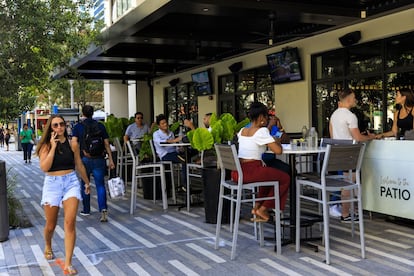The ‘new’ Latino-American
The upcoming U.S. presidential election will inevitably lead to a much-needed national reckoning on the state of the Latino community, forcing us to face questions we’ve feared to answer for far too long: Just how united are Latinos today? Can we truly call ourselves a tight- knit ‘community’?

In many ways, the survival of modern American democracy, now threatened by authoritarian undercurrents, rests on the premise that America’s minorities will jointly rise in the face of strongmen like Donald Trump. It rests on the notion that the social fabric that allegedly weaves Latinos together — our past, our cultural heritage, our immigrant experience — is at odds with Trumpism. Yet that presumption is based on an old, fabricated label — “the Latino community” — that designated commonality to millions of Latin Americans of different backgrounds and ethnicities that migrated to the U.S. in the 20th century. Decades later, this land that once felt foreign is home to them, and newer generations of Latinos are left wondering whether our identities, values and vision can still be captured under one roof.
I am a first-generation Latina who was born in Miami to a Cuban exile whose family fled Cuba and a Mexican immigrant. My parents were part of the post 1960′s mass Latin American migration wave to the U.S., which fundamentally changed the country. For years, the Latin American-born population rose from less than one million in 1960 to almost 19 million in 2010. From the Cuban Revolution to Mexico’s dire economic opportunities to Central America’s civil wars, millions of Latin Americans like my parents left past lives to find new beginnings North. By the time I was born in 1987, the federal government had coined a term to classify this new and rapidly growing segment of individuals of Latin American descent. They called us “Hispanic,” eventually “Latinos.” Ironically, while those words attempted to capture our distinctiveness from the rest of Anglo-Americans, they also distilled our own diversity and individualism, confining us to a term that was never equipped to foresee the future.
Ever since my parents came to this country in the 60s and the early 80s, millions of immigrants inevitably Americanized, gradually assimilating into a country whose dark history with racism pushed many to believe that the American Dream was best achieved in English. Slowly, Spanish accents transformed into Spanglish, Mexican outdoor flags were accompanied by red, white, and blue colors, and many immigrants gave birth to children with American sounding first names. And now that the post-60s mass migration wave has plateaued and newborns, rather than immigrants, are fueling the U.S. Latino population, younger generations of Latinos seem to be finding homes in completely different sides of America’s cultural spectrum.
Some U.S. Latinos are leaning into multiple identities that may have once been suppressed in Latin American motherlands, taking pride in a diversity that is supposed to mirror the American future. For instance, over 27 million Latinos identify as multi-racial today, a significant increase from 2010 when only 3 million identified with more than one race. Polls also show that LGBTQ-identification is higher among Latinos than any other demographic, or that young Latinos are increasingly religiously unaffiliated or mobilizing for reproductive rights and finding newfound solidarity with the Palestinian movement. They may be “Latino” on paper, but they may also identify as Black first, or as Afro-Latinos, or as Brown, or as queer, or simply, as American.
Yet other Latinos have instead opted to emulate America’s white majority, progressively embracing tendencies that fuel Trumpism. After four years in the White House, more Latinos voted for Trump in 2020 than they did in 2016. The projection is for those numbers to continue to surge, in great part because Trump’s anti-immigrant rhetoric and messianic message seems to be resonating. Polls show that Latino Protestants are increasingly supporting Christian nationalism and my own reporting has exposed the way xenophobia is slowly slipping in through the back door of Latino households. Instead of seeing immigrants with empathy or as reflections of themselves, many are criminalizing them and viewing asylum seekers as existential threats to their well-being. In fact, discrimination isn’t just limited to those at the southern border. According to Pew Research, over 40% of Latinos with darker skin color have experienced discrimination by another Latino in the U.S. This group may be “Latino” on paper, but they may also identify as white first, or mixed, or simply as American.
During the wave of the post 1960′s migration, newly arrived Latin Americans were surrounded with unfamiliar faces that suddenly found common ground in their collective quest to find belonging in America. With that, the terms “Hispanic” or “Latino community” fabricated the illusion of a populace that would always be bound together by a set of common dreams, language, and traditions. Decades later, what exactly do 62.5 million Latinos see in each other now? Was it all simply a myth?
Each generation has defied and expanded the meaning of the labels that have been attributed to us. Yet the 2024 election will be a true test of our unanimity, exposing whether that social fabric that has historically united us is able to withstand today’s divisiveness. No matter what the answer to that question is, we will surely witness the emergence of a new and telling chapter of Latino history. What will we label that?
Sign up for our weekly newsletter to get more English-language news coverage from EL PAÍS USA Edition
Tu suscripción se está usando en otro dispositivo
¿Quieres añadir otro usuario a tu suscripción?
Si continúas leyendo en este dispositivo, no se podrá leer en el otro.
FlechaTu suscripción se está usando en otro dispositivo y solo puedes acceder a EL PAÍS desde un dispositivo a la vez.
Si quieres compartir tu cuenta, cambia tu suscripción a la modalidad Premium, así podrás añadir otro usuario. Cada uno accederá con su propia cuenta de email, lo que os permitirá personalizar vuestra experiencia en EL PAÍS.
¿Tienes una suscripción de empresa? Accede aquí para contratar más cuentas.
En el caso de no saber quién está usando tu cuenta, te recomendamos cambiar tu contraseña aquí.
Si decides continuar compartiendo tu cuenta, este mensaje se mostrará en tu dispositivo y en el de la otra persona que está usando tu cuenta de forma indefinida, afectando a tu experiencia de lectura. Puedes consultar aquí los términos y condiciones de la suscripción digital.
More information
Archived In
Últimas noticias
Welcome to the post-religion era: The idea of Christianity as the absolute truth has become obsolete
‘I thought you would like it’: The risky sexual practice popularized by TV shows and TikTok
The digitalization of tourism: ‘They promise experiences and gave us the worst possible one’
Mexican peso defies uncertainty with forecasts of a new period of stability in 2026
Most viewed
- Sinaloa Cartel war is taking its toll on Los Chapitos
- Reinhard Genzel, Nobel laureate in physics: ‘One-minute videos will never give you the truth’
- Oona Chaplin: ‘I told James Cameron that I was living in a treehouse and starting a permaculture project with a friend’
- Why the price of coffee has skyrocketed: from Brazilian plantations to specialty coffee houses
- Silver prices are going crazy: This is what’s fueling the rally










































